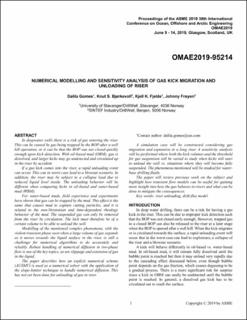| dc.contributor.author | de Sousa Gomes, Dalila | |
| dc.contributor.author | Bjørkevoll, Knut Steinar | |
| dc.contributor.author | Fjelde, Kjell Kåre | |
| dc.contributor.author | Frøyen, Johnny | |
| dc.date.accessioned | 2023-01-19T15:58:28Z | |
| dc.date.available | 2023-01-19T15:58:28Z | |
| dc.date.created | 2019-11-20T16:35:33Z | |
| dc.date.issued | 2019 | |
| dc.identifier.citation | Gomes, D., Bjørkevoll, K. S., Fjelde, K. K., & Frøyen, J. (2019, June). Numerical modelling and sensitivity analysis of gas kick migration and unloading of riser. In International Conference on Offshore Mechanics and Arctic Engineering (Vol. 58875, p. V008T11A033). American Society of Mechanical Engineers. | en_US |
| dc.identifier.isbn | 978-0-7918-5887-5 | |
| dc.identifier.uri | https://hdl.handle.net/11250/3044736 | |
| dc.description.abstract | In deepwater wells there is a risk of gas entering the riser. This can be caused by gas being trapped by the BOP after a well kill operation, or it can be that the BOP was not closed quickly enough upon kick detection. With oil-based mud (OBM), gas is dissolved, and larger kicks may go undetected and circulated up in the riser by accident. If a gas kick comes into the riser, a rapid unloading event can occur. This can in worst case lead to a blowout scenario. In addition, the riser may be subject to a collapse load due to reduced liquid level inside. The unloading behavior will be different when comparing kicks in oil-based and water-based mud (WBM). For water-based muds, field experience and experiments have shown that gas can be trapped by the mud. This effect is the same that causes mud to capture cutting particles, and it is related to the non-Newtonian and time-dependent rheology behavior of the mud. The suspended gas can only be removed from the riser by circulation. The kick must therefore be of a certain volume to be able to unload the well. Modelling of the mentioned complex phenomena, with the violent transient phase seen when a large volume of gas expands as it moves towards the liquid surface in the riser, is still a challenge for numerical algorithms to do accurately and reliably. Robust handling of numerical diffusion in two-phase flow is one of the key topics, as are slippage and extension of gas in the liquid. The paper describes how an explicit numerical scheme (AUSMV) is used as a numerical solver with the application of the slope-limiter technique to handle numerical diffusion. This has not yet been done for unloading of gas in riser. A simulation case will be constructed considering gas migration and expansion in a long riser. A sensitivity analysis will be performed where both the kick volumes and the threshold for gas suspension will be varied to study when kicks will start to unload the well vs. situations where they will become fully suspended. The phenomena mentioned will be studied for water-base drilling fluids. The paper will review previous work on the subject and highlight how transient flow models can be useful for gaining more insight into how the gas behaves in risers and what can be done to mitigate the consequences. | en_US |
| dc.language.iso | eng | en_US |
| dc.publisher | ASME | en_US |
| dc.relation.ispartof | ASME 2019 38th International Conference on Ocean, Offshore and Arctic Engineering (OMAE2019): Volume 8: Polar and Arctic Sciences and Technology; Petroleum Technology | |
| dc.title | Numerical Modelling and Sensitivity Analysis of Gas Kick Migration and Unloading of Riser | en_US |
| dc.type | Chapter | en_US |
| dc.description.version | acceptedVersion | en_US |
| dc.subject.nsi | VDP::Teknologi: 500 | en_US |
| dc.identifier.doi | 10.1115/OMAE2019-95214 | |
| dc.identifier.cristin | 1750084 | |
| dc.relation.project | Norges forskningsråd: 203525 | en_US |
| cristin.unitcode | 217,8,6,0 | |
| cristin.unitname | Institutt for energi- og petroleumsteknologi | |
| cristin.ispublished | true | |
| cristin.fulltext | postprint | |
| cristin.qualitycode | 1 | |
